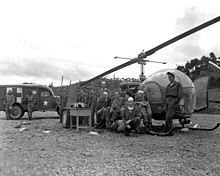This article needs additional citations for verification. (February 2011) |

Mobile Army Surgical Hospitals (MASH) were U.S. Army field hospital units conceptualized in 1946 as replacements for the obsolete World War II-era Auxiliary Surgical Group hospital units.[1] MASH units were in operation from the Korean War to the Gulf War before being phased out in the early 2000s, in favor of combat support hospitals.[1][2]
Each MASH unit had 60 beds, as well as surgical, nursing, and other enlisted and officer staff available at all times.[1] MASH units filled a vital role in military medicine by providing support to army units upwards of 10,000 to 20,000 soldiers.[3] These units had a low mortality rate compared to others, as the transportation time to hospitals was shorter, resulting in fewer patients dying within the "Golden Hour",[4] the first hour after an injury is first sustained, which is referred to in trauma as the "most important hour".[4] The U.S. Army deactivated the last MASH unit on February 16, 2006.
- ^ a b c "Mobile army surgical hospital". www.britannica.com. Retrieved 2021-11-18.
- ^ "Goodbye, farewell and amen to the last US Mash unit". The Guardian. 2006-02-07. Retrieved 2021-11-18.
- ^ "Masthead". Journal of the National Medical Association. 101 (2): 97. February 2009. doi:10.1016/s0027-9684(15)30816-6. ISSN 0027-9684.
- ^ a b Karras, D. J. (2006-05-01). "Emergency Medicine Research Directors: Society for Academic Emergency Medicine 2005 Survey Results". Academic Emergency Medicine. 13 (5Supplement 1): S202–S203. doi:10.1197/j.aem.2006.03.515. ISSN 1069-6563.